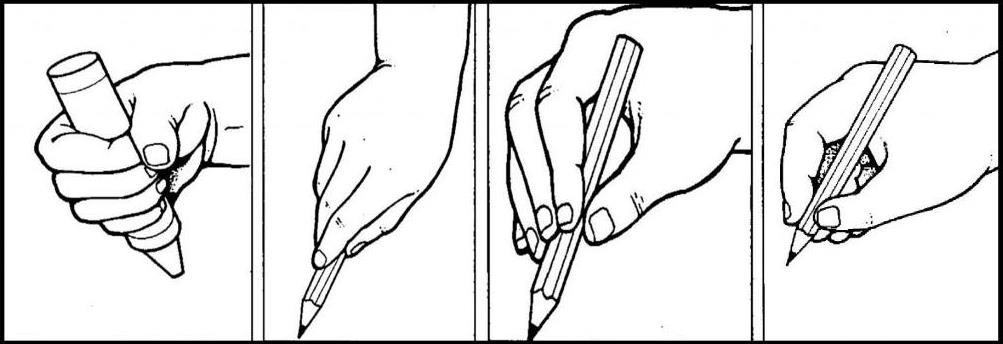Let’s Get A Grip: The Development of Pencil Grasp in Children
The development of a proper pencil grasp is an important milestone for children, as it not only allows them to write accurately but also promotes their fine motor development.
Read on to learn how important the development of the pencil grasp is and discover effective strategies for teaching it to your child.
When Do Children Start Learning Pencil Grasp?
As children grow and learn, many significant milestones mark different stages of their development.
One of these milestones is the development of pencil grasp, which is crucial for learning to write and equally important for fine motor development.
Proper pencil grasp development for writing starts a lot earlier than you think in children. From the time your child starts grasping for objects with their hands, they are developing basic grasping skills.
Now let’s discuss why pencil grasp is so important and provide some strategies for teaching it.
Why is Pencil Grasp Important?
Pencil grasp is an essential skill for children learning to write.
The ability to hold a pencil correctly allows children to form letters and shapes accurately and efficiently.
Developing a strong pencil grasp requires coordination of small muscles in the hand, fingers and wrist. These muscles also help with other tasks like tying shoes, buttoning clothes and using utensils.
Unfortunately, in Australia, one in five children start school with difficulties with their fine motor skills, which can negatively impact their ability to learn and progress academically.
It’s essential to develop these skills in children as early as possible to ensure they have the best chance of success in school and beyond.
The 4 Stages of Pencil Grasp Development
It’s important to remember that pencil grasp develops over time. Becoming frustrated when your child doesn’t hold a pencil properly, despite not having developed the motor skills to do so, will only make learning an unpleasant experience for you both.
Instead, measure their progress through the 4 stages of pencil grasp development as seen below.
Children are clever little creatures! They want to be able to write legibly and without fatiguing themselves. So rest assured, as their hand dexterity and strength develop, they’ll naturally come to start to adopt a proper pencil grasp.
Strategies for Teaching Pencil Grasp
Teaching pencil grasp can be challenging, but there are many strategies parents and educators can use to help children develop this skill. Here are some effective techniques:
1. Start with pre-writing exercises
Pre-writing exercises such as tracing, colouring, and drawing can help children develop hand-eye coordination and control over their writing tools. These exercises also help to develop the muscles in the hands and fingers.
2. Encourage the use of playdough and manipulatives
Squeezing play dough and using tweezers to pick up small objects can help improve grip strength and promote fine motor development.
Using scissors can also be an integral part of developing the fine motor control needed to use a pencil. Check out our blog where we share some awesome cutting activities children will enjoy.
3. Use smaller writing tools
This is a favourite tip among occupational therapists. Use small writing tools like golf pencils, broken crayons, short markers or small crayon rocks. Using smaller tools means that children cannot use their entire hand to grasp, therefore they must use some form of a pencil grasp – even if it is still slightly immature.
Using small writing tools also encourages children to work more deliberately, making smaller, more precise movements like those of writing numbers and letters.
4. Offer a variety of writing tools
Let’s face it, using a pencil isn’t very fun! But a range of markers, crayons, and coloured pencils are more appealing to children.
Offering a range of writing materials will not only keep children interested but will help strengthen the hands as well as mimic the actual pencil grasp.
5. Keep it fun
Parents and teachers can sometimes feel pressured to have their children use a mature pencil grasp as soon as possible, but keep in mind that it is a developmental process.
When teaching pencil grasp, it’s so important to keep things light-hearted and fun! Children at this age don’t benefit from added pressure, so look for creative ways to develop pencil grasp rather than requiring your child to sit down and trace lines all day.
Have a read of our previous blog where we share fun ideas to help develop children’s fine motor skills.
Common Pencil Grasp Problems and Solutions
Some children may have difficulty developing proper pencil grasp, which can lead to writing fatigue, discomfort or inefficient grip. However, there are solutions to these problems:
Inefficient grip
Modify the pencil grip by using pencil grips or try triangular pencils to help promote proper pencil grasp and efficient writing.
Painful or fatigued hands
Encouraging breaks, doing hand stretches or using a fidget tool can help alleviate discomfort and prevent hand fatigue.
Remember, every child develops at their own pace, so be patient and provide plenty of positive feedback along the way. By doing so, you’ll help set your child up for success both in school and in life.
Looking for a Loving and Nurturing Environment for Your Children to Grow?
Every child is unique and full of potential.
At Little Miracles we love seeing each and every child in our care grow and develop, believe in who they are and have plenty of fun along the way!
Contact us today to learn more about how we can provide your child with the care and support they need to thrive.




